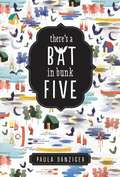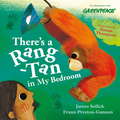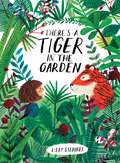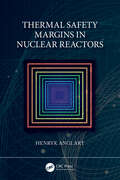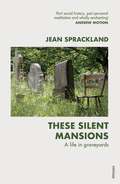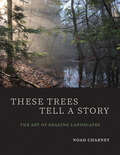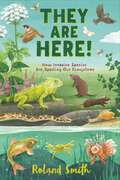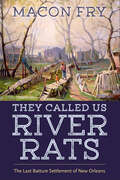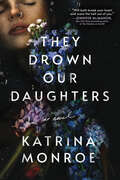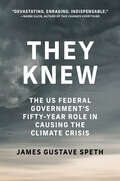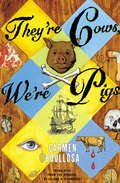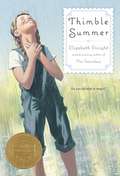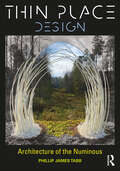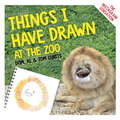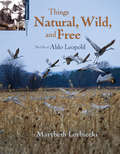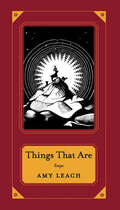- Table View
- List View
There's a Bat in Bunk Five
by Paula Danziger Ann M MartinA gorgeous new package for Paula Danziger's backlist with an introduction from Ann Martin!Marcy Lewis is thrilled when her former teacher Ms. Finney asks her to be a junior counselor at a creative arts camp. Finally, she's on her own for the first time, away from family and school. It's her big chance to reinvent herself. Marcy's sure everything will be perfect--until the campers arrive. Being surrounded by nosy, giggling, joke-telling girls (and one nightmare camper in particular) is enough to make her want to jump in a lake. Her only solace is her nights out with Ted, a sweet, guitar-playing boys' counselor. But is Marcy ready for that? Can she handle a potential boyfriend and the demands of twelve campers for an entire summer? And are there really bats in the ceiling of the dining hall?Paula Danziger's novels are hilarious, genuine, and full of dynamic female characters that have won the hearts of her readers and turned her books into beloved classics. These playful covers full of charming details capture the spirit of Paula's stories and will brighten up the bookshelves of her fans and a new generation of readers.
There's a Bat in Bunk Five
by Paula DanzigerOn her own for the first time, 14-year-old Marcy tries to cope with the new people and situations she encounters while working as a counselor at an arts camp.
There's a Rang-Tan in My Bedroom
by James SellickA stunning picture book about one little girl and her orangutan friend, based on the Greenpeace film that became a viral sensation.When a little girl discovers a mischievous orangutan on the loose in her bedroom, she can't understand why it keeps shouting OOO! at her shampoo and her chocolate. But when Rang-tan explains that there are humans running wild in her rainforest, burning down trees so they can grow palm oil to put in products, the little girl knows what she has to do: help save the orangutans! Published in collaboration with Greenpeace, featuring a foreword from Dame Emma Thompson and brought to life by award-winning illustrator Frann Preston-Gannon, this is a very special picture book with a vital message to share.Extra pages at the back include information about orangutans and palm oil plus exciting ideas about how young readers can make a difference.
There's a Tiger in the Garden
by Lizzy StewartA gorgeous and imaginative debut picture book by author/illustrator Lizzy Stewart, perfect for fans of Emily Hughes, Peter Brown, and Julie Morstad. There’s nothing to do at Grandma’s house and Nora refuses to believe any outlandish tales of dragonflies as big as birds, grumpy polar bears who like to fish, or a magnificent tiger all allegedly residing in Grandma’s garden. Nora's too old for silly games. But this charming picture book proves you are never too young or too old to dream--and adventure can find you when you least expect it. When Grandma says she's seen a tiger in the garden, Nora doesn't believe her. She's too old to play Grandma's silly games! Everyone knows that tigers live in jungles, not gardens. So even when Nora sees dragonflies as big as birds, and plants that try to eat her toy giraffe, and a polar bear that likes fishing, she knows there's absolutely, DEFINITELY no way there could be a tiger in the garden . . . Could there?
Thermal Safety Margins in Nuclear Reactors
by Henryk AnglartThis book presents an overview of state-of-the art approaches to determine thermal safety margins in nuclear reactors. It presents both the deterministic and probabilistic aspects of thermal safety margins of nuclear reactors to facilitate the understanding of these two difficult topics at various academic levels, from undergraduates to researchers in nuclear engineering.It first sets out the theoretical background before exploring how to determine thermal safety margins in nuclear reactors, through examples, problems and advanced state-of-the-art approaches. This will help undergraduate students better understand the most fundamental aspects of nuclear reactor safety. For researchers and practitioners, this book provides a comprehensive overview of most recent achievements in the field, offering an excellent starting point to develop new methods for the assessment of the thermal safety margins.This book is written to bridge the gap between deterministic and appropriate treatment of uncertainties to assess safety margins in nuclear reactors, presenting these approaches as complementary to each other. Even though these two approaches are frequently used in parallel in real-world applications, there has been a lack of a consistent teaching approach in this area.This book is suitable for readers with a background in calculus, thermodynamics, fluid mechanics, and heat transfer. It is assumed that readers have previous exposure to such concepts as laws of thermodynamics, enthalpy, entropy, and conservation equations used in fluid mechanics and heat transfer.Key Features: Covers the theory, principles, and assessment methods of thermal safety margins in nuclear reactors whilst presenting the state-of-the-art technology in the field Combines the deterministic thermal safety considerations with a comprehensive treatment of uncertainties, offering a framework that is applicable to all current and future commercial nuclear reactor types Provides numerous examples and problems to be solved
Thermal and Mineral Waters
by James W. Lamoreaux Werner Balderer Adam Porowski Hussein IdrisThis is a compilation of manuscripts on mineral and thermal waters of different areas of the world. This special volume is devoted to the 41st Meeting of the Commission on Mineral and Thermal Waters of International Association of Hydrogeologists (IAH-CMTW) held in Cairo, Egypt, in October 2009. The presentations collected and presented in this volume show the variety of aspects of mineral and thermal waters occurrence and utilization in different countries of the world with a special focus on Egypt, Iran, Ukraine, Poland, Russia and Australia.
These Rocks Count!
by Sarah Snow Alison FormentoMr. Tate's class is about to learn that there's more to rocks than being dirty lumps on the ground. On this field trip they're visiting the rocky ridge mountains to learn about rocks. At first the children think rocks will be boring, but they soon learn that rocks are all around us in ways we might not expect--such as glass and toothpaste! This is a fixed-format ebook, which preserves the design and layout of the original print book.
These Seas Count!
by Sarah Snow Alison FormentoMr. Tate’s class helps clean up a local beach and listens to the sea as it tells them about all the wildlife that make it their home. One whale, two giant sea turtles, three marlins . . . and more. Of course, the class discovers that “this sea counts!” These Seas Count! explores the environmental impact and importance of the seas, and how crucial it is to keep them healthy. Alison Formento’s gentle story and Sarah Snow’s amazing collages combine for a powerful message about the environment and what we can do to preserve our oceans.
These Silent Mansions: A life in graveyards
by Jean Sprackland'A refreshingly original meditation... I wish I had written it myself' Literary ReviewGraveyards are oases: places of escape, peace and reflection. Liminal sites of commemoration, where the past is close enough to touch. Yet they also reflect their living community - how in our restless, accelerated modern world, we are losing our sense of connection to the dead.Jean Sprackland - the prize-winning poet and author of Strands - travels back through her life, revisiting her once local graveyards. In seeking out the stories of those who lived and died there, remembered and forgotten, she unearths what has been lost.
These Trees Tell a Story: The Art of Reading Landscapes
by Noah CharneyA deeply personal master class on how to read a natural landscape and unravel the clues to its unique ecological history Structured as a series of interactive field walks through ten New England ecosystems, this book challenges readers to see the world through the eyes of a trained naturalist. With guided questions, immersive photography, and a narrative approach, each chapter adds layers of complexity to a single scene, revealing the millions of years of forces at play. Tying together geology, forest ecology, wildlife biology, soil processes, evolution, conservation, and more, Noah Charney shows how and why landscapes appear in their current forms. Charney&’s stories and lessons will provide anyone with the necessary investigative skills to look at a landscape, interpret it, and tell its story—from its start as rock or soil to the plants and animals that live on it. Ultimately, Charney argues, by critically engaging with the landscape we will become better at connecting with nature and ourselves.
They Are Here!: How Invasive Species Are Spoiling Our Ecosystems
by Roland SmithFrom the New York Times-bestselling author, Roland Smith, comes a fascinating, fact-filled resource that explores how humans have introduced—on purpose and by accident—plants and animals to parts of the world where they were previously unknown. . .sometimes with disastrous results. Did you know that brown rats were brought to the United States in the eighteenth century on a ship from England? Or that thousands of exotic pets were released into the Florida Everglades after a hurricane in 1992, leading to today’s booming Burmese python population? All over the country, non-native species from around the world have been introduced to our lands, irrevocably changing the natural balances of their new habitats. This is the story of some of those newcomers, but also of human error and nature gone wild. By looking at thirty different intrusive plants and animals, They Are Here! explores invasive species, their impact on our environment, and the steps we can take to support local ecosystems under threat.
They Called Us River Rats: The Last Batture Settlement of New Orleans
by Macon FryThey Called Us River Rats: The Last Batture Settlement of New Orleans is the previously untold story of perhaps the oldest outsider settlement in America, an invisible community on the annually flooded shores of the Mississippi River. This community exists in the place between the normal high and low water line of the Mississippi River, a zone known in Louisiana as the batture. For the better part of two centuries, batture dwellers such as Macon Fry have raised shantyboats on stilts, built water-adapted homes, foraged, fished, and survived using the skills a river teaches. Until now the stories of this way of life have existed only in the memories of those who have lived here. Beginning in 2000, Fry set about recording the stories of all the old batture dwellers he could find: maritime workers, willow furniture makers, fishermen, artists, and river shrimpers. Along the way, Fry uncovered fascinating tales of fortune tellers, faith healers, and wild bird trappers who defiantly lived on the river. They Called Us River Rats also explores the troubled relationship between people inside the levees, the often-reviled batture folks, and the river itself. It traces the struggle between batture folks and city authorities, the commercial interests that claimed the river, and Louisiana’s most powerful politicians. These conflicts have ended in legal battles, displacement, incarceration, and even lynching. Today Fry is among the senior generation of “River Rats” living in a vestigial colony of twelve “camps” on New Orleans’s river batture, a fragment of a settlement that once stretched nearly six miles and numbered hundreds of homes. It is the last riparian settlement on the Lower Mississippi and a contrarian, independent life outside urban zoning, planning, and flood protection. This book is for everyone who ever felt the pull of the Mississippi River or saw its towering levees and wondered who could live on the other side.
They Came but Could Not Conquer: The Struggle for Environmental Justice in Alaska Native Communities
by Diane J. PurvisAs the environmental justice movement slowly builds momentum, Diane J. Purvis highlights the work of Indigenous peoples in Alaska&’s small rural villages, who have faced incredible odds throughout history yet have built political clout fueled by vigorous common cause in defense of their homes and livelihood. Starting with the transition from Russian to American occupation of Alaska, Alaska Natives have battled with oil and gas corporations; fought against U.S. plans to explode thermonuclear bombs on the edge of Native villages; litigated against political plans to flood Native homes; sought recompense for the Exxon Valdez oil spill disaster; and struggled against the federal government&’s fishing restrictions that altered Native paths for subsistence. In They Came but Could Not Conquer Purvis presents twelve environmental crises that occurred when isolated villages were threatened by a governmental monolith or big business. In each, Native peoples rallied together to protect their land, waters, resources, and a way of life against the bulldozer of unwanted, often dangerous alterations labeled as progress. In this gripping narrative Purvis shares the inspiring stories of those who possessed little influence over big business and regulations yet were able to protect their traditional lands and waterways anyway.
They Drown Our Daughters
by Katrina Monroe"The best kind of story—one that will both break your heart and scare the hell out of you." —Jennifer McMahon, New York Times bestselling author of The Children on the HillIf you can hear the call of the water,It's already far too late.They say Cape Disappointment is haunted. That's why tourists used to flock there in droves. They'd visit the rocky shoreline under the old lighthouse's watchful eye and fish shells from the water as they pretended to spot dark shapes in the surf. Now the tourists are long gone, and when Meredith Strand and her young daughter return to Meredith's childhood home after an acrimonious split from her wife, the Cape seems more haunted by regret than any malevolent force.But her mother, suffering from early stages of Alzheimer's, is convinced the ghost stories are real. Not only is there something in the water, but it's watching them. Waiting for them. Reaching out to Meredith's daughter the way it has to every woman in their line for generations—and if Meredith isn't careful, all three women, bound by blood and heartbreak, will be lost one by one to the ocean's mournful call.Part queer modern gothic, part ghost story, They Drown Our Daughters explores the depths of motherhood, identity, and the lengths a woman will go to hold on to both.
They Knew: The US Federal Governments Fifty-Year Role in Causing the Climate Crisis
by James Gustave SpethA devastating, play-by-play account of the federal government's leading role in bringing about today's climate crisis.In 2015, a group of twenty-one young people sued the federal government for violating their constitutional rights by promoting the climate catastrophe, depriving them of life, liberty, and property without due process of law. They Knew offers evidence for their claims, presenting a devastating, play-by-play account of the federal government's role in bringing about today's climate crisis. James Speth, tapped by the plaintiffs as an expert on climate, documents how administrations from Carter to Trump--despite having information about climate change and the connection to fossil fuels--continued aggressive support of a fossil fuel based energy system. What did the federal government know and when did it know it? Speth asks, echoing another famous cover up. What did the federal government do and what did it not do? They Knew (an updated version of the Expert Report Speth prepared for the lawsuit) presents the most compelling indictment yet of the government's role in the climate crisis, showing a forty-year failure to take action. Since Juliana v. United States was filed, the federal government has repeatedly delayed the case. Yet even in legal limbo, it has helped inspire a generation of youthful climate activists. An Our Children&’s Trust Book
They Lead: The Wolf Pack
by June SmallsThey are the leaders. The creators of the pack. She digs the den, where their young will grow. He patrols the territory and brings her food while she cares for the helpless pups. As seasons pass, and new litters arrive, the pack grows and all work together to raise the young. A wolf&’s piercing howl can carry up to 10 miles, raising goosebumps on even the most intrepid camper&’s skin. But the gray wolf is far from a simple predator. An incredible combination of teamwork and instinct has helped wolf packs survive, despite being endangered in most of North America. With a mother wolf and father wolf leading the pack–their family–together, the cubs grow and learn the skills they need to start their own pack someday. With stunning, lifelike illustrations and facts on each page for grownups or older children who want a deeper dive, this beautiful picture book is a monument to these majestic packs.
They're Cows, We're Pigs (Books That Changed the World)
by Carmen BoullosaA dark, thought-provoking adventure that “artfully evokes the blood-soaked reality of 17th-century pirates” (Entertainment Weekly).This “wryly humorous, satiric, and often macabre novel” (Library Journal) follows Jean Smeeks, a Flemish thirteen-year-old who signs up as an indentured servant with the French West Indies Company, but instead winds up a slave on the notorious island of Tortuga. Over time, he learns the arts of herbal medicine and surgery—a skill that allows him to join a band of Caribbean pirates. Contrasting Jean’s romantic pull toward the “Brethren of the Coast”—an all-male society pursuing socialist, anti-colonialist ideals—with the brutal reality of their lawless existence, They’re Cows, We’re Pigs is a “unique and memorable” novel whose “pirate world leaves you as a good book should: thinking” (The Boston Herald).
Thimble Summer
by Elizabeth EnrightA few hours after nine-year-old Garnet Linden finds a silver thimble in the dried-up riverbed, the rains come and end the long drought on the farm. The rains bring safety for the crops and the livestock, and money for Garnet's father. Garnet can't help feeling that the thimble is a magic talisman, for the summer proves to be interesting and exciting in so many different ways. <P><P>There is the arrival of Eric, an orphan who becomes a member of the Linden family; the building of a new barn; and the county fair at which Garnet's carefully tended pig, Timmy, wins a blue ribbon. Every day brings adventure of some kind to Garnet and her best friend, Citronella. As far as Garnet is concerned, the thimble is responsible for each good thing that happens during this magic summer--her thimble summer.
Thin Place Design: Architecture of the Numinous
by Phillip James TabbWhat makes the places we inhabit extraordinary? Why are some urban spaces more vital and restorative? Wonderful landscapes, inspiring works of architecture and urban design, and the numinous experiences that accompany them have been an integral dimension of our culture. Up-lifting spaces, dramatic use of natural light, harmonic proportional geometry, magical landscapes, historic sites and vital city centers create special, even sacred moments in architecture and planning. This quality of experience is often seen as an aesthetic purpose intended to inspire, ennoble, ensoul and spiritually renew. Architecture and urban spaces, functioning in this way, are considered to be thin places.
Things I Have Drawn: At the Zoo
by Tom CurtisKIDS' DRAWINGS HILARIOUSLY BROUGHT TO LIFE.Have you ever wondered what the world would look like if children's drawings were real? Well, wonder no more. Global Instagram sensation THINGS I HAVE DRAWN does just that - and the results are AMAZING.8-year-old Dom and 6-year-old Al are brothers who love to doodle, and then Dad Tom painstakingly transforms their creations into photorealistic scenes. In this book, join the family on a trip to the zoo and laugh your socks off at all of the weird and wonderful creatures, including a gurning goat, a terrifying polar bear and a rather smug looking flamingo. Spectacularly funny and disturbing, this book is packed with previously unseen material and the brilliant before and after images that have made @thingsihavedrawn such a cult hit.
Things I Learned from Falling: The must-read true story
by Claire NelsonAn inspirational and gripping first-person account of determination, adversity and survival against the odds.'Uplifting and brave' - Stylist'A riveting account of loneliness, anxiety and survival' - Cosmopolitan'A vibrantly physical book' - the Guardian'Claire Nelson relives a life-changing four days' - The Times'What a story; never heard a story like that before' - Chris EvansIn 2018, Claire Nelson made international headlines. She was in her thirties and was beginning to burn out - her hectic London life of work and social activity and striving to do more and do better in the big city was frenetic and stressful. Although she was surrounded by people all of the time, she felt increasingly lonely.When the anxiety she felt finally brought her to breaking point, Claire decided to take some time off and travelled to Joshua Tree Park in California to hike and clear her head. What happened next was something she could never have anticipated.While hiking, Claire fell 25 feet, gravely injuring herself and she lay alone in the desert - mistakenly miles off any trail, without a cell phone signal, fighting for her life. She lay in the elements for four days until she was miraculously found - her rescuers had not expected to find her alive.In THINGS I LEARNED FROM FALLING Claire tells her incredible story and what it taught her about loneliness, anxiety and transformation and how to survive it all.(p) 2020 Octopus Publishing Group
Things I Learned from Falling: The must-read true story
by Claire NelsonAn inspirational and gripping first-person account of determination, adversity and survival against the odds.'What a story; never heard a story like that before' - Chris Evans'Uplifting and brave' - Stylist'A riveting account of loneliness, anxiety and survival' - Cosmopolitan'A vibrantly physical book' - the Guardian'Claire Nelson relives a life-changing four days' - The TimesIn 2018, Claire Nelson made international headlines.The relentless pace of work, social activity and striving to do more and better in the big city was frenetic and stressful. Surrounded by people, Claire was increasingly lonely - and beginning to burn out. When the anxiety she felt finally brought her to breaking point, Claire decided to take some time out and travelled half-way around the world to clear her head. What happened next, on a hike in California, was something she could never have anticipated.Things I Learned from Falling is an incredible story of courage, determination and survival against the odds. Utterly gripping and profoundly moving, this inspirational memoir reminds us all how easily life can go off course, how simply we can lose touch with the truly important and that - even when we are utterly broken - we can be made whole again.
Things Natural, Wild, and Free
by Marybeth LorbieckiAs a child, Aldo Leopold was always looking for adventures in nature. This led Leopold to become a forester, wildlife scientist, author, and ultimately one of the most well-known conservationists in American history. Award-winning author Marybeth Lorbiecki brings Leopold to life in this biography enhanced with historic photographs and a school resource section.Marybeth Lorbiecki is the author of more than twenty-five books for children and adults, and she teaches upper-level college writing and children's literature as an adjunct university professor. Her adult biography Aldo Leopold: A Fierce Green Fire earned a Minnesota Book Award.
Things That Are: Essays
by Amy LeachEssays by a Whiting Award winner: “Like a descendant of Lewis Carroll and Emily Dickinson . . . one of the most exciting and original writers in America.” —Yiyun Li, author of Must I GoThings That Are takes jellyfish, fainting goats, and imperturbable caterpillars as just a few of its many inspirations. In a series of essays that progress from the tiniest earth dwellers to the most far-flung celestial bodies—considering the similarity of gods to donkeys, the inexorability of love and vines, the relations of exploding stars to exploding sea cucumbers—Amy Leach rekindles a vital communion with the wild world, dormant for far too long. Things That Are is not specifically of the animal, the human, or the phenomenal; it is a book of wonder, one the reader cannot help but leave with their perceptions both expanded and confounded in delightful ways.This debut collection comes from a writer whose accolades precede her: a Whiting Award, a Rona Jaffe Award, a Best American Essays selection, and a Pushcart Prize, all received before her first book-length publication. Things That Are marks the debut of an entirely new brand of nonfiction writer, in a mode like that of Ander Monson, John D’Agata, and Eula Biss, but a new sort of beast entirely its own.“Explores fantastical and curious subjects pertaining to natural phenomena . . . for those interested in looking at the natural world through the lens of a fairy tale, this is a bonbon of a book.” —Kirkus Reviews
Things That Grow
by Meredith GoldsteinAfter her grandmother dies, a girl travels to different gardens to scatter her ashes, learning about life and love along the way. From Love Letters advice columnist and podcast host Meredith Goldstein, this emotionally resonant novel with a touch of humor is perfect for fans of Robin Benway and Jenna Evans Welch. When Lori&’s Dorothy Parker–loving grandmother dies, Lori&’s world is turned upside down. Grandma Sheryl was everything to Lori—and not just because Sheryl raised Lori when Lori&’s mom got a job out of town. Now Lori&’s mom is insisting on moving her away from her beloved Boston right before senior year. Desperate to stay for as long as possible, Lori insists on honoring her grandmother&’s last request before she moves: to scatter Sheryl&’s ashes near things that grow. Along with her uncle Seth and Chris, best friend and love-of-her-life crush, Lori sets off on a road trip to visit her grandmother&’s favorite gardens. Dodging forest bathers, scandalized volunteers, and angry homeowners, they come to terms with the shape of life after Grandma Sheryl. Saying goodbye isn&’t easy, but Lori might just find a way to move forward surrounded by the people she loves.

